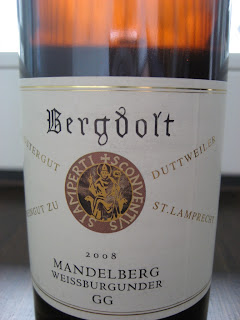
Like his brother
Fritz,
Martin Waßmer runs a sizeable seasonal asparagus and strawberry growing operation on the plains just to the south of Freiburg. However, like Fritz as well, his real passion is Burgundy and, specifically, the C
ôte d'Or. After visiting the world's premier Pinot Noir region himself, visiting seminars, learning secrets from the greats etc., he left the local wine cooperative in 1999 to set up on his own. One of his first practical measures was to replace his old Spätburgunder vines with low-yielding Burgundian clones. Tasting the following wine, the reason he did so becomes apparent.
Weingut Martin Waßmer, Spätburgunder Qba trocken 2007 Costs EUR 8.40 normally, but I bought this one for EUR 6.50 as a bin-end. Judging from Waßmer's website, this wine wasn't matured in oak barrels (or
Barriques, as they say in "German"), but in a larger wooden vat instead. Still, the oak influence is obvious at first, and it's obvious that this wine needs plenty of air. After pouring a second glass 24 hours after opening, everything is in harmony.
Make no mistake: this is a substantial wine for what you pay for. On the nose, it reminds me of those
chocolate-dipped strawberries you often get at weddings. The aromas, you feel, are still in "bass". The treble notes are yet to emerge. However, there are hints of fruit and spice to come, but the oak influence - without actually smelling of oak - keeps the nose extremely structured and
deep. On the palate, the effect is considerable. It's like landing on a bed of velvet. There is a lot of complexity in the background, but at this early stage in the wine's development, the lines are slightly fuzzy. I mean this in a good way, though. Definitely a food wine and highly recommended. No shortage of potential here.
 Following my recent Spätburgunders, another random bin-end. Not usually seen on the shelves of my supermarket of choice, this bottle suddenly appeared out of nowhere last week, selling for just 2.99 euro - almost half its normal retail price.
Following my recent Spätburgunders, another random bin-end. Not usually seen on the shelves of my supermarket of choice, this bottle suddenly appeared out of nowhere last week, selling for just 2.99 euro - almost half its normal retail price.




